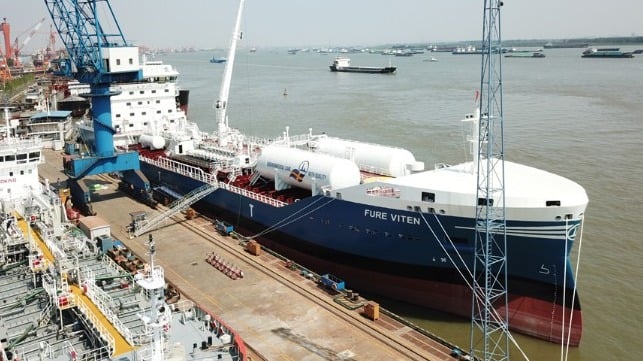New Tanker Demonstrates Potential to Exceed IMO’s Emissions Targets

Acclaiming their newest vessel as “an international flagship concerning the environment and climate,” the Swedish shipowner Furetank reports that through the use of advanced systems they were able to achieve a very low environmental score, helping the company to already meet the IMO’s emission targets for 2050. The tanker incorporates a range of technologies building on current vessel designs, including dual-fuel gas propulsion, batteries, and shore power.
The 17,999 dwt tanker Fure Viten was built at the China Merchants Jinling Shipyard Dingheng Co. and is currently preparing to leave the Yangzhou shipyard for deployment. The tanker, which is 492 feet long with a beam of 75 feet, has a cargo capacity of 20,300 cubic meters in 12 tanks. The hull is 1A ice class and it will be registered in Sweden.
Designed by Furetank and FKAB Marine Design in collaboration with Wärtsilä, the aim was to reduce fuel consumption as much as possible. Throughout the design and construction process, energy efficiency has been increased. “There is not a single system that we haven’t improved. This combination of interacting, energy-saving technical solutions is unique,” says Lars Höglund, CEO of Furetank.
Among the design features that Furetank is highlighting are batteries that help reduce the use of auxiliary engines, a ducted propeller increases thrust and reduces power requirement, an improved hull shape minimizes drag, and the main engine and shaft generator use of variable frequency to increase propeller efficiency and reduce fuel consumption.
One of a class of eight vessels, Fure Viten will be operated with LBG (liquefied biogas) or LNG (liquefied natural gas). According to the company, through the use of gas fuel in combination with technical optimizations, emissions of climate-affecting carbon dioxide have been reduced by 55 percent compared to older vessels and eutrophic nitrogen oxide (NOx) by 86 percent. Emissions of acidifying sulfur oxide (SOx) and hazardous particles (PM) are basically eliminated.
The IMO is regulating emissions from new vessels through the EEDI energy efficiency design index, where a lower value means less emissions. Today, the requirement for a vessel the size of Fure Viten is to reach below 9.37 points, but Fure Viten reached a value as low as 4.65 points, which according to Furetank are the best results achieved so far in the size segment
Höglund highlighted one of the key considerations for all shipowners investing in new vessels of how to future-proof current designs for future regulations. “We will operate the ships we build now for the coming 20 years, so we have put a lot of effort into investigating what is the best possible technology that we can invest in today. Climate change is a reality and we believe that politicians mean what they say. Thus, if we are to survive as a shipping company in the future, we must do our absolute best to reduce our climate and environmental impact.”
The Fure Viten and her earlier preceding sister ship the Fure Vinga are also the first tankers in Europe that are fully equipped to operate their energy-demanding cargo pumps with 6.6 kV high voltage shore power. This will reduce emissions even further as soon as ports offer the opportunity. Currently, Gothenburg and Rotterdam, are in the process of developing the full capacity power connection required to operate the pumps with shore power.
“The next step will be to operate the ships completely without fossil fuels,” says Höglund. “We are in the process of securing the supply of larger quantities of biogas within a year or so, through an exclusive agreement with a supplier. My view is that in 2030 we will run these vessels largely on LBG with zero fossil emissions."
With the delivery of Fure Viten, the average carbon dioxide emissions from Furetank's intermediate fleet have been decreased by 50 percent compared to 2008. The company highlights that the deployment of these new vessels fulfills its part of the IMO's total emission target for the world fleet to halve emissions by 2050.
